Sensitivity (updated June 2023)
This page provides the information on instrumental sensitivities necessary to plan MODS spectroscopic and imaging observations.
There have been gradual changes in the sensitivities of both instruments (or rather the instrument+telescope, which is what was measured) over time, most dramatically for MODS1, on the LBT-SX side, whose sensitivity has declined by ~1 magnitude since the instrument was commissioned in 2011.
One of the contributors to the changing MODS1+LBT-SX sensitivity has been the degradation of the coating on the SX adaptive secondary (ASM). On 25 May 2023, the SX ASM was removed and replaced by the rigid secondary. Lab measurements indicated relative reflectivities of the SX ASM with respect to the rigid of 0.54, 0.66 and 0.72 at 4200, 5220 and 6500 angstroms, respectively, and the flux ratios derived from MODS zeropoints measured on 20230526 UT (“after”) and on 20230210 UT (“before”) are roughly consistent with these measurements. The “before” to “after” flux ratios at a discrete set of wavelengths are plotted below for direct grating and dual grating modes.
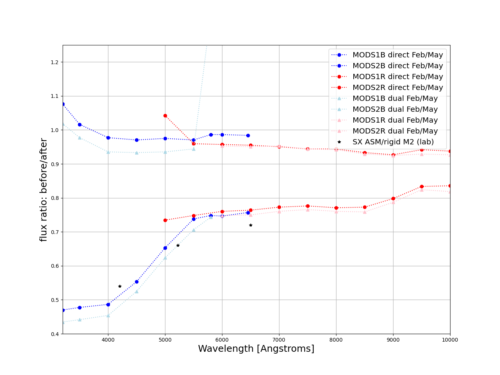
Figure 1: Flux ratios derived from the sets of tabulated zeropoints for a spectrophotometric standard observed on 20230210 UT and 20230526 UT (after the SX M2 was swapped). For the direct grating modes, these are 0.52, 0.68 and 0.76 at 4200, 5220 and 6500 angstroms, consistent with the relative reflectivities of the SX ASM and rigid secondary. The relative ratios should be the same for dual and direct modes, so the difference in the blue channel is interesting. The ratios at the endpoints may be questionable.
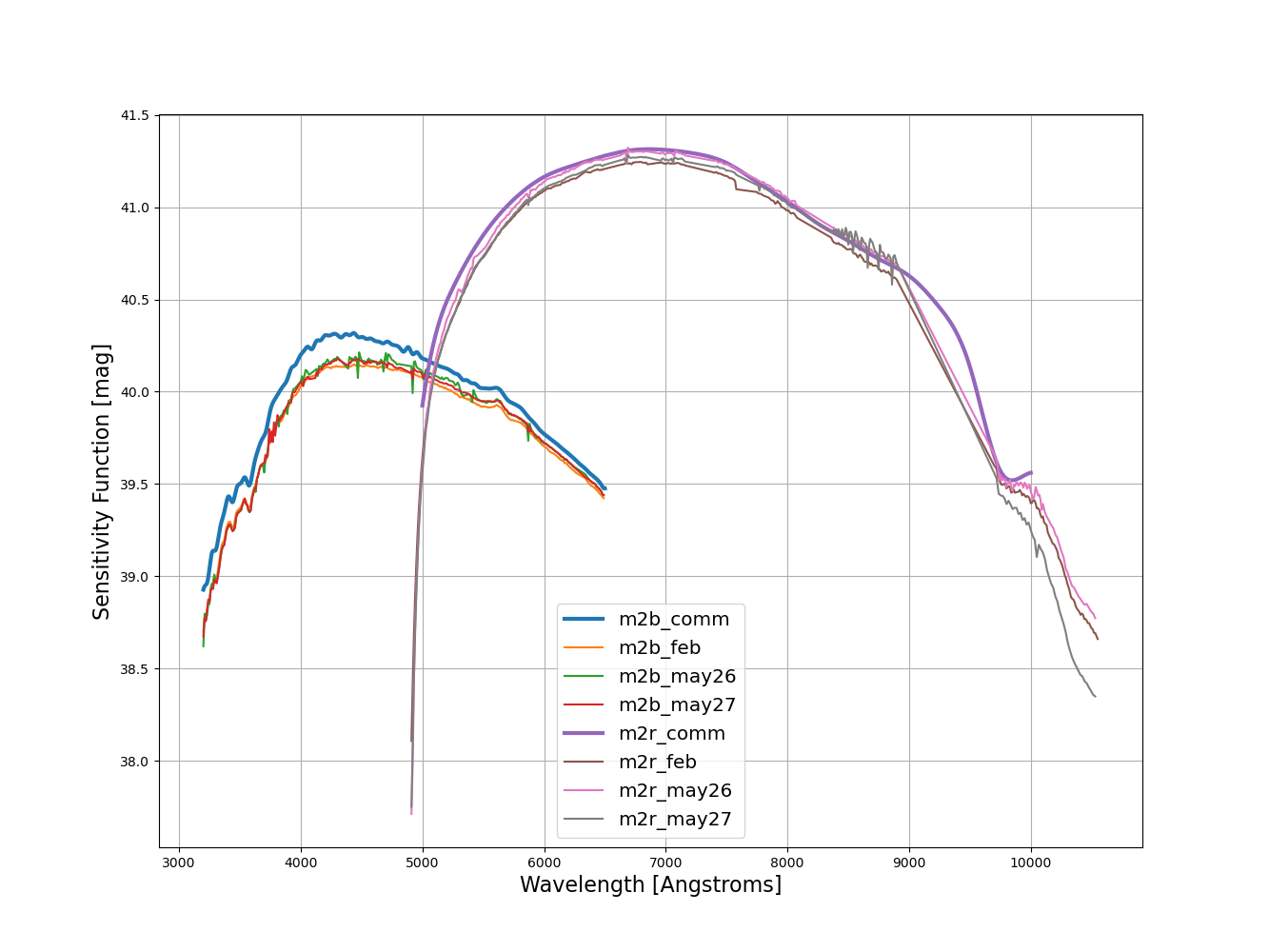
Figure 2: The evolution of the sensitivities for the direct modes of MODS1+LBT-SX (top) and MODS2+LBT-DX (bottom), from their respective commissionings in 2011 & 2015, to February 2023 and finally to May 2023 after the SX M2 swap.
With the secondary mirror swap, the relative photon flux ratio of MODS1 with respect to MODS2 is now 0.9-1 at the blue end, but at the red end, it is about 0.5-0.6. Assuming the same relative flux ratios for signal and sky, and that the dominant source of noise is the sky background, then to achieve the same SNR with MODS1 as with MODS2 in the red would require an exposure that is almost twice as long.
The grating zeropoints, grating signal-to-noise tracks and imaging zeropoints have been updated using the 26 May 2023 data.
Spectroscopic Mode
The number of counts per angstrom that may be expected from a source with flux, Fλ , at a given wavelength, airmass and exposure time, can be estimated using the following formula and the zeropoint at that wavelength, log Sλ ,0.
log Sλ = log Sλ ,0 + log Fλ + log texp – 0.4 Kλ X
where:
log Sλ = log counts in ADU Å-1 at wavelength λ
log Sλ ,0 = Spectroscopic zero point in ADU Å-1at wavelength, see tables below.
Fλ = flux in units of erg/sec/cm2/Å
texp = exposure time in seconds
Kλ = estimated extinction coefficient at wavelength λ
X = airmass at the time of the observation
To convert AB magnitudes to Fλ:
log Fλ = -0.9608 – 0.4 AB – 2 log λ
where AB = Spectral AB magnitude and λ is the wavelength in Angstroms.
The spectroscopic zero points at selected wavelengths for the MODS red and blue grating and prism modes are listed in the Tables 1a and 2 below. For a given source flux (Fλ), exposure time and airmass, these allow a 10-20% prediction of counts per angstrom, Sλ, which can be converted to counts per pixel when multiplied by the spectral pixel size in Å. The effect of atmospheric extinction is factored in by selecting a nominal airmass for the observation and applying an appropriate model for the atmospheric extinction (see below). A caveat — predictions based on these zero points should be considered as for the best-case scenario, as there are various observational factors that can degrade the sensitivity achieved: slit losses, which depend on seeing among other factors; changes in sky brightness with time, telescope pointing or moon phase and distance from target; changes in transparency; and changes in the reflectivities of the telescope or instrument optics, are some examples.
Grating Mode
The efficiencies for the grating spectroscopic modes, based on MODS1+SX and MODS2+DX data from May 26, 2023 UT. These efficiencies are for MODS1 plus the LBT SX primary and secondary mirrors and MODS2 plus the LBT DX primary and secondary mirrors and are exclusive of the atmosphere (i.e. using the diameters of the primaries and their central obscurations, but assuming perfect reflectivities and assume airmass=0). The efficiency of MODS1+SX has decreased by approximately a factor of 2 since the time of commissioning when efficiencies were similar to those of MODS2. The decrease is wavelength-dependent. Also, the red-only efficiencies of both MODS1 and MODS2 have decreased with respect to the dual modes above 6000 or 7000 angstroms, possibly due to some degradation of the Ag coatings on the flat mirrors in the red channel. The upturn in red-only modes above 9700 Angstroms is due to 2nd order light that is not blocked by the GG495 filter which has a cut-on wavelength of 4950 Angstroms.
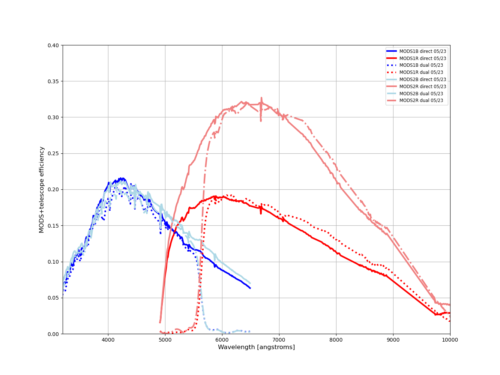
Figure 3: MODS1+SX and MODS2+DX airmass=0 efficiencies for direct (solid) and dual (dotted) grating modes from data taken in May 2023. The top pair of blue & red curves is for MODS2 and the bottom, for MODS1. All curves assume perfect reflectivity for the primary and secondary mirrors, which is not be realistic, and so the value of the plot is mainly in illustrating the relative instrument+telescope throughputs.
The replacement of the SX ASM with the rigid secondary improved the sensitivity of MODS1+LBT-SX, but while the blue end recovered to almost the level at commissioning and is now comparable to MODS2+LBT-DX, the red end saw a smaller improvement.
Zeropoints
The spectroscopic zero points as a function of wavelength for the MODS1 and MODS2 grating modes, log Sλ ,0, are given in Table 1a below. These are based on data taken on 20230526 UT, after the SX adSec was swapped out for the rigid secondary.
Table1a: MODS1+LBT-SX and MODS2+LBT-DX Grating Mode Spectroscopic Zero Points (26 May 2023 UT)
| MODS1 Red Grating | MODS2 Red grating | MODS1 Blue Grating | MODS2 Blue grating | ||||||
|---|---|---|---|---|---|---|---|---|---|
| λ(Å) | Direct logSλ,0 |
Dichroic log Sλ ,0 |
Direct logSλ,0 |
Dichroic log Sλ ,0 |
λ(Å) | Direct logSλ,0 |
Dichroic log Sλ ,0 |
Direct logSλ,0 |
Dichroic log Sλ ,0 |
| 5000 | 15.632 | … | 15.84 | … | 3200 | 15.382 | 15.33 | 15.448 | 15.387 |
| 5500 | 16.004 | 14.504 | 16.309 | 14.992 | 3500 | 15.688 | 15.653 | 15.74 | 15.712 |
| 6000 | 16.076 | 16.072 | 16.455 | 16.44 | 4000 | 16.012 | 15.972 | 16.022 | 15.976 |
| 6500 | 16.083 | 16.099 | 16.503 | 16.501 | 4500 | 16.05 | 16.024 | 16.069 | 16.051 |
| 7000 | 16.07 | 16.089 | 16.516 | 16.519 | 5000 | 15.985 | 15.976 | 16.041 | 16.035 |
| 7500 | 16.036 | 16.085 | 16.493 | 16.522 | 5500 | 15.907 | 15.882 | 15.98 | 15.945 |
| 8000 | 15.977 | 16.039 | 16.418 | 16.456 | 5800 | 15.863 | 14.584 | 15.94 | 14.572 |
| 8500 | 15.916 | 15.975 | 16.338 | 16.367 | 6000 | 15.82 | … | 15.888 | … |
| 9000 | 15.82 | 15.879 | 16.225 | 16.251 | 6450 | 15.725 | … | 15.789 | … |
| 9500 | 15.577 | 15.632 | 15.967 | 15.997 | |||||
| 10000 | 15.2(*) | 15.264 | 15.539(*) | 15.569 | |||||
*: In the red direct mode, there is 2nd order contamination above 9700 angstroms and the zeropoint is taken to be the dual grating zeropoint minus the rounded average dual-to-direct offset at the red end of 0.06 dex (MODS1) or 0.03 dex (MODS2).
For comparison, the zeropoints in Table 1b are based on data taken in September and October 2022.
Table1b: MODS1+LBT-SX and MODS2+LBT-DX Grating Mode Spectroscopic Zero Points (Sep-Oct 2022 UT)
| MODS1 Red Grating | MODS2 Red grating | MODS1 Blue Grating | MODS2 Blue grating | ||||||
|---|---|---|---|---|---|---|---|---|---|
| λ(Å) | Direct logSλ,0 |
Dichroic log Sλ ,0 |
Direct logSλ,0 |
Dichroic log Sλ ,0 |
λ(Å) | Direct logSλ,0 |
Dichroic log Sλ ,0 |
Direct logSλ,0 |
Dichroic log Sλ ,0 |
| 5000 | 15.501 | … | 15.865 | … | 3200 | 15.091 | 15.016 | 15.485 | 15.431 |
| 5500 | 15.910 | 14.420 | 16.319 | 15.013 | 3500 | 15.388 | 15.349 | 15.766 | 15.746 |
| 6000 | 15.995 | 15.985 | 16.465 | 16.458 | 4000 | 15.728 | 15.681 | 16.026 | 15.992 |
| 6500 | 16.001 | 16.011 | 16.511 | 16.516 | 4500 | 15.814 | 15.788 | 16.070 | 16.059 |
| 7000 | 15.993 | 16.005 | 16.522 | 16.534 | 5000 | 15.819 | 15.809 | 16.045 | 16.044 |
| 7500 | 15.970 | 16.009 | 16.505 | 16.542 | 5500 | 15.797 | 15.763 | 15.991 | 15.955 |
| 8000 | 15.902 | 15.958 | 16.432 | 16.477 | 5800 | 15.764 | 14.459 | 15.956 | 14.597 |
| 8500 | 15.843 | 15.897 | 16.350 | 16.386 | 6000 | 15.719 | … | 15.902 | … |
| 9000 | 15.753 | 15.816 | 16.232 | 16.268 | 6450 | 15.622 | … | 15.799 | … |
| 9500 | 15.521 | 15.570 | 15.965 | 16.008 | |||||
| 10000 | 15.420 | 15.208 | 15.793 | 15.571 | |||||
SNR tracks
Figures 4.1, 4.2 and 4.3, below, plot the sensitivity limits as a function of time for a given signal-to-noise ratio. These are based on measurements made with MODS1 and MODS2 on May 26, 2023 UT, after the SX ASM was replaced by the rigid secondary. The calculation of these SNR tracks assumes a Gaussian PSF to account for slit losses and to determine the contribution from the sky, where an extraction window of 2.4 * FWHM rows, which would contain 99.5% of the light from an unresolved source, is used.
Figure 4.1 (below): SNR tracks for MODS1 & MODS2 at g and r: For signal-to-noise ratios, SNR= 5, 20 and 100 per 0.5 (blue) or 0.85 angstrom (red) pixel in a spectrum that has been extracted over the number of rows corresponding to the seeing FWHM, tracks of AB magnitude vs time are plotted for both blue (at g_sdss/4770 angstroms) and red (r_sdss/6300 angstroms) channels. These tracks use the MODS1 and MODS2 dual grating zeropoints tabulated here and have been calculated for a 1″ slit, seeing FWHM = 1″, airmass = 1 and dark (new moon, solid lines) and bright (10-d moon, dotted lines) skies. The blue and red shaded regions indicate the range of magnitudes predicted for sky brightnesses from new to 10-d moon. The slit loss calculation assumes a Gaussian PSF, so for a slit width equal to the seeing FWHM, 24 percent of the light is lost. For the sky contribution, the area is the number of pixels covered by the slit width times the FWHM. The dark(bright) sky brightnesses at g_sdss and r_sdss were assumed to be 22.3(20.7) and 21.3(20.6), respectively. These are interpolated from the KPNO sky brightnesses and agree well with published dark sky values for Mt. Graham (Taylor+2004,PASP,116,762 and Pedani 2009, PASP,121,778).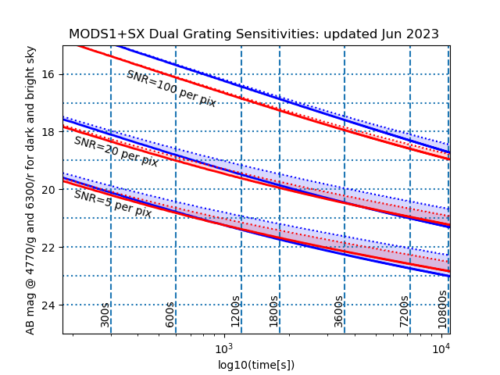
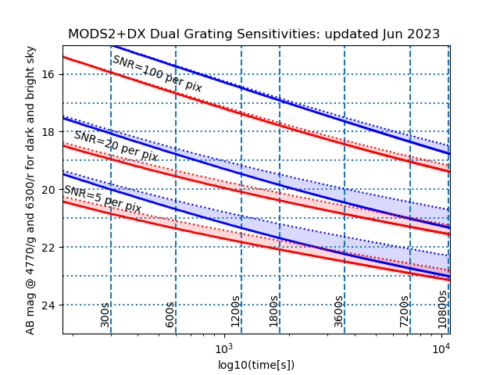
To do a “bye-eye interpolation” from this plot, recall that the SNR scales with the square root of the flux and of the exposure time, although for fainter objects whose flux is comparable to the sky brightness, SNR grows more slowly.
Caveat: The predicted SNRs should be considered best-case scenarios, as there are various observational factors that can degrade the actual SNR you see in your data: transparency, slit loss, sky brightness which can change with time (in the red, for example) and with telescope pointing (looking at a low elevation target in the direction of a city, e.g.). Also the predictions are based on photon statistics and do not account for uncertainties introduced in the data processing (e.g. flat-fielding errors). At the red end of the optical, especially at z, where the sky is brighter that at r and the CCD quantum efficiency is dropping, the predicted SNRs will be worse.
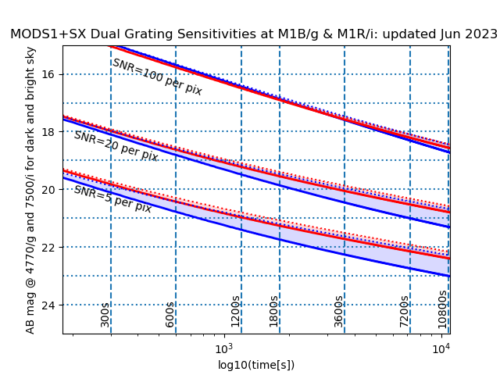 |
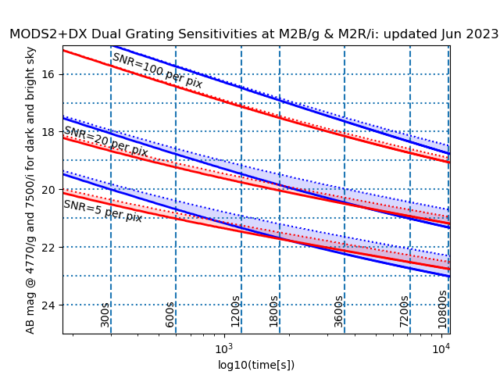 |
Figure 4.2 The same as in Figure 2.1, but the red channel predictions are made at i (7500 angstroms) instead of at r. At i, the sky brightnesses have been assumed to be 20.7 mag/sq.arcsec (dark) and 20.2 mag/sq.arcsec (bright).
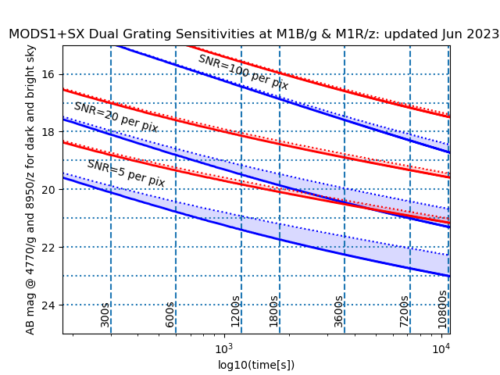 |
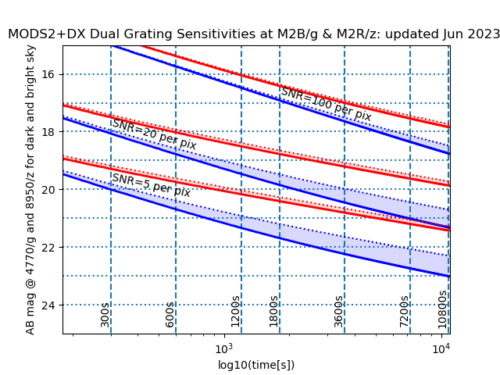 |
Figure 4.3 The same as in Figure 2.1, but the red channel predictions are made at z (8950 angstroms) instead of at r. At z, the sky brightnesses have been assumed to be 19.0 mag/sq.arcsec (dark) and 18.7 mag/sq.arcsec (bright).
Prism Mode (not updated; from MODS1 commissioning)
The efficiency curves, exclusive of the atmosphere, for dual and direct prism modes are shown below. (Note: These are for the MODS1 commissioning data from 2011, and as for the grating and imaging modes, we can expect a decline in the sensitivity of MODS1+SX. These should NOT be compared with the efficiency curves for the grating mode in Figure 3. These curves will be updated.)
Spectroscopic zero points as a function of wavelength for the MODS1 prism modes are tabulated below:
Table 2: MODS1 Prism Mode Spectroscopic Zero Points (based on MODS1 commissioning data 2011)
| Red Prism | Blue Prism | ||||||
|---|---|---|---|---|---|---|---|
| log Sλ ,0 | Pixel | log Sλ ,0 | Pixel | ||||
| λ (Å) | Direct | Dichroic | δ λ (Å) | λ (Å) | Direct | Dichroic | δ λ (Å) |
| 5000 | 15.722 | … | 2.6 | 3600 | 15.663 | 15.640 | 3.4 |
| 5500 | 16.178 | 14.978 | 3.4 | 3850 | 15.886 | 15.858 | 4.4 |
| 6000 | 16.268 | 16.265 | 4.6 | 4030 | 15.978 | 15.927 | 5.1 |
| 6450 | 16.301 | 16.293 | 5.9 | 4500 | 16.121 | 16.096 | 7.1 |
| 7000 | 16.357 | 16.348 | 7.6 | 5000 | 16.162 | 16.138 | 9.8 |
| 7450 | 16.365 | 16.368 | 9.1 | 5500 | 16.172 | 16.112 | 12.7 |
| 8000 | 16.342 | 16.350 | 11.2 | 6000 | 16.143 | 15.478 | 15.8 |
| 8500 | 16.307 | 16.297 | 13.3 | 6450 | 16.082 | … | 18.5 |
| 8800 | 16.264 | 16.252 | 14.6 | 7000 | 15.964 | … | 21.8 |
| 9750 | 15.740 | 15.692 | 18.9 | ||||
| 10000 | 15.396 | 15.333 | 20.1 | ||||
The same formula for estimating counts per exposure time used for the grating mode apply to data in this table for the prism, but bear in mind that the size of spectral pixel is a strongly varying function of wavelength. Nominal pixel sizes for each channel, δλ (Å), are given in Table 2 above.
 |
Figure 6: For signal-to-noise ratios, SNR= 5, 20 and 100 per pixel in a prism spectrum that has been extracted over the number of rows corresponding to the seeing FWHM, tracks of AB magnitude vs time are plotted for both blue (at g_sdss/4770 angstroms) and red (r_sdss/6300 angstroms) channels. These tracks use the MODS1 dual prism zeropoints tabulated here and have been calculated for a 1″ slit, seeing FWHM = 1″, airmass = 1 and dark (new moon, solid lines) and bright (10-d moon, dotted lines) skies. With the prisms, the number of angstroms per pixel increases with wavelength, from ~3 angstroms/pix to ~20 angstroms/pix (see Table 2 above), so while the zeropoints for the prism and grating are similar, the predicted SNR per pixel is greater for the prism than for the grating, all other input parameters being equal. The blue and red shaded regions indicate the range of magnitudes predicted for sky brightnesses from new to 10-d moon. The slit loss calculation assumes a Gaussian PSF, so for a slit width equal to the seeing FWHM, 24 percent of the light is lost. For the sky contribution, the area is the number of pixels covered by the slit width times the FWHM. The dark(bright) sky brightnesses at g_sdss and r_sdss were assumed to be 22.3(20.7) and 21.3(20.6), respectively. These are interpolated from the KPNO sky brightnesses and agree well with published dark sky values for Mt. Graham (Taylor+2004,PASP,116,762 and Pedani 2009, PASP,121,778).
To do a “bye-eye interpolation” from this plot, recall that the SNR scales with the square root of the flux and of the exposure time, although for fainter objects whose flux is comparable to the sky brightness, SNR grows more slowly. Caveat: The predicted SNRs should be considered best-case scenarios, as there are various observational factors that can degrade the actual SNR you see in your data: transparency, slit loss, sky brightness which can change with time (in the red, for example) and with telescope pointing (looking at a low elevation target in the direction of a city, e.g.). Also the predictions are based on photon statistics and do not account for uncertainties introduced in the data processing (e.g. flat-fielding errors). At the red end of the optical, especially at z, where the sky is brighter that at r and the CCD quantum efficiency is dropping, the predicted SNRs will be worse.
Imaging Mode
Estimates of the imaging sensitivity of MODS are based on measurements of secondary photometric standard stars in the SDSS AB magnitude system (Clem, VandenBerg, and Stetson (2008)), and, for those fields not covered by Clem et al, measurements of stars in the SDSS DR12 catalog. By manipulation of the photometric conversion formula:
mf = mf,0 – 2.5 log Sf + 2.5 log texp – Kf X ;
the predicted integrated counts in ADU in a filter given its SDSS AB magnitude in the filter band is given by:
log Sf = log Sf,0 – 0.4mf + log texp – 0.4 K f X
where:
log Sf = log counts in ADU for filter f
log Sf,0 = ADU zero point (counts for mf=0.0mag in 1 second) listed in the table below. [log Sf,0 = 0.4 mf,0]
mf = SDSS magnitude in filter f in AB units
mf,0 = photometric zero point magnitude in filter f in AB units listed in the table below.
texp = exposure time in seconds
Kf = estimated extinction coefficient for filter f
X = airmass at the time of the observation
Imaging Zeropoints
Preliminary photometric zeropoints in dual and direct imaging modes, derived from observations of the field of M13 during May 26 2023 UT, are given in Table 3a, along with the extinction coefficients that were assumed. Table 3b lists the zeropoints that were measured from images of 4 fields with SDSS DR12 coverage observed on Feb 10 2023 UT, which were in good agreement with results based on data taken on 2021 Oct 27 UT.
The changes in the imaging zeropoints as a result of the secondary mirror swap are consistent with the spectrophotometry. The relative MODS1-to-MODS2 fluxes are also similar to what is measured for the spectrophotometry, except at u_sdss, and this difference could be explained by the lower throughput of the u_sdss filter in MODS1 with respect to the one in MODS2.
Table 3a: Preliminary MODS ugirz Zeropoints from 26 May 2023 (after M2 swap)
| Filter | MODS1 | MODS1 | MODS2 | MODS2 | Kf (mag/airmass) |
|---|---|---|---|---|---|
| mf,0 (mag) direct |
mf,0 (mag) dual |
mf,0 (mag) direct |
mf,0 (mag) dual |
||
| SDSS u | 25.56 | 25.46 | 26.05 | 25.92 | 0.47 |
| SDSS g | 27.25 | 27.2 | 27.40 | 27.32 | 0.17 |
| SDSS r | 26.65 | 26.63 | 27.77 | 27.63 | 0.10 |
| SDSS i | 26.50 | 26.57 | 27.55 | 27.53 | 0.05 |
| SDSS z | 25.84 | 25.86 | 27.03 | 26.97 | 0.03 |
Table 3b: Zeropoints(a) from 10 Feb 2023 UT
| Filter | MODS1 | MODS1 | MODS2 | MODS2 | Kf (mag/airmass) |
|---|---|---|---|---|---|
| mf,0 (mag) direct |
mf,0 (mag) dual |
mf,0 (mag) direct |
mf,0 (mag) dual |
||
| SDSS u | 24.80±0.13 (0.37) | 24.71±0.15 (0.26) | 26.11±0.05 (0.11) | 26.04±0.06 (0.08) | 0.47 |
| SDSS g | 26.81±0.06 (0.02) | 26.75±0.06 (0.03) | 27.46±0.06 (0.02) | 27.39±0.04 (0.04) | 0.17 |
| SDSS r | 26.41±0.09 (0.06) | 26.35±0.15 (0.06) | 27.82±0.03 (0.05) | 27.69±0.06 (0.06) | 0.10 |
| SDSS i | 26.29±0.10 (0.03) | 26.36±0.15 (0.08) | 27.63±0.03 (0.02) | 27.60±0.04 (0.07) | 0.05 |
| SDSS z | 25.67±0.10 (0.07) | 25.67±0.10 (0.08) | 27.10±0.05 (0.06) | 27.04±0.04 (0.15) | 0.03 |
(a) The zeropoint and error was taken to be the median of the 4 or 5 images per configuration, and the number in parenthesis represents the spread. The spread is, in most cases, smaller than the standard deviation for an image, but when it is large, as at u, it cannot be explained by residual extinction and is probably is real scatter in the very small set of stars that were detected in some fields.
The table below is based on MODS1 commissioning data taken in 2011, and these are the zeropoints used by the Imaging ETC. (We are working on a new ETC for spectroscopic and imaging modes that will use the latest zeropoints – 2023 June 05). When planning imaging, for science or for spectroscopic acquisition, a good rule of thumb is: The peak pixel will saturate on an r = 15th mag in 30 sec in 0.6 arcsec seeing.
| Filter | mf,0 (mag) | Kf | log Sf,0 |
|---|---|---|---|
| SDSS u | 25.68±0.12 | 0.47 | 10.25 |
| SDSS g | 27.38±0.03 | 0.17 | 10.94 |
| SDSS r | 27.24±0.03 | 0.10 | 10.90 |
| SDSS i | 27.21±0.04 | 0.05 | 10.91 |
| SDSSz | 26.41±0.04 | 0.03 | 10.58 |
Model LBT Atmospheric Extinction
Table 4: LBT Model Extinction Curve
| λ (Å) | Kλ |
| 3200 | 0.866 |
| 3500 | 0.511 |
| 4000 | 0.311 |
| 4500 | 0.207 |
| 5000 | 0.153 |
| 5500 | 0.128 |
| 6000 | 0.113 |
| 6450 | 0.088 |
| 6500 | 0.085 |
| 7000 | 0.063 |
| 7500 | 0.053 |
| 8000 | 0.044 |
| 8210 | 0.043 |
| 8260 | 0.042 |
| 8370 | 0.041 |
| 8708 | 0.026 |
| 10256 | 0.020 |
The coefficients in this model LBT extinction curve do not include strong telluric absorption features, so this correction should be done with caution if using it to predict signal in a given exposure time at wavelengths in proximity to strong telluric features.


